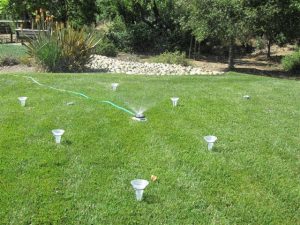Smart Irrigation in the Hot Summer Garden
In past articles we’ve talked about evapotranspiration, the movement of water from the ground into the air. Water evaporates into warm air or wind from a surface (such as the soil surface in your garden). Plants take water up through their roots, use it in metabolic processes, and release it as water vapor through their leaves (transpiration).
Throughout the Sierra foothills, July is the month with the highest average rate of evapotranspiration. This makes sense when you consider the high temperatures in July. The Irrigation Association designated July as “Smart Irrigation Month,” with good reason. Even though this year’s water supply is more than ample, we can still follow some common sense suggestions for smart use of one of our most precious natural resources. Following are some water-saving tips from the Irrigation Association:
1. Adapt your watering schedule to the weather and the season. Obviously, in the recent heat, many plants (tomatoes and pumpkins, for example) need water every day. Feel the soil around your plants, dig down to the level of the roots. Observe whether there’s adequate water in the soil. As temperatures cool into fall, plants need less water. And during the winter in the Mother Lode, it’s usually not necessary to water at all.
Consider applying a few inches of mulch to the soil surface around thirsty plants. Mulch cools the soil temperature, reducing evaporation, which allows water to remain in the soil for a longer period of time where plant roots can find it. Mulch on the surface can reduce water use by up to 50%.
2. Inspect your irrigation system monthly; adjust sprinkler heads. Look for leaks, broken sprinkler heads, and misaligned heads. Flush out clogged drip emitters and micro-spray heads. Often water isn’t being applied evenly; although the sprinklers are running, some areas may be getting too little water. Adjust sprinkler heads so that areas that don’t need water—asphalt, sidewalks, streets and roads—aren’t being watered. Avoid “urban drool.”
3. Consider “smart” technology or a rain shutoff switch. There are climate and soil-moisture sensor-based controllers that will evaluate and calculate a watering schedule based on conditions in your microclimate. And rain shutoff switches can be retrofitted to your current irrigation system, thus saving money and water when it rains.
4. Consider low volume drip or micro irrigation. Gardens, trees and shrubs can all be irrigated using drip emitters, micro spray jets or bubblers. Low volume systems irrigate slowly, allowing water to be absorbed by our clay soils, and minimizing evaporation, runoff and overspray.
Apply only as much water as needed. Too much water in the root zone for long periods can be damaging to plants due to a reduction in oxygen around the root hairs. This can occur when irrigation is performed too frequently in an amount too great for the plant to remove and use.
Also consider reducing the size of your lawn. This is not England, with its damp, foggy weather pattern that reduces transpiration. Grass is one of the biggest water losers around. In fact, one of the reference standards for evapotranspiration (against which all other plants are measured) is turf grass completely covering the ground to a depth of four to six inches.
And one last tip—go to www.ipm.ucdavis.edu and click on “UC Guide to Healthy Lawns” to learn more about irrigating your lawn. Or go to www.tudwater.com and click on “Conservation” to learn more about water savings outdoors.
Rebecca Miller-Cripps is a University of California Cooperative Extension of Master Gardener of Tuolumne County.

